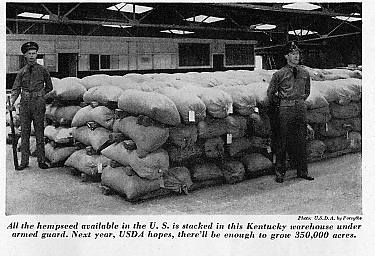
| HEMPOLOGY.ORG: THE STUDY OF HEMP
|
|||
|
|
||
Pubdate: June, 1942
Source: Farm Journal and Farmer's Wife
Author: Unknown
Page: 17

Caption: "All the hempseed available in the U.S. is stacked in this Kentucky warehouse under armed guard. Next year, USDA hopes, there'll be enough to grow 350,000 acres." (Photo credit: U.S.D.A. by Forsythe)
WAR DEMANDS MORE HEMP
Tall, tough "thin man" of the nettle family, hemp is normally imported from the Philippines and the Dutch East Indies. In peace time, it made a big share of the $192,000,000 worth of fiber and fiber products America shipped in each year. Yet hemp has been grown in Kentucky since 1775, has made money for a small group of raisers in Wisconsin for the past few years. Experts claim it is a 90-day crop, standing eight degrees of frost and producing from four to six tons of stalks per acre on land good for 35 to 60 bu. of corn. At current prices, it will bring about $33 per ton.
Last month, hard put for rope, twine and a quick source of cellulose, the Department of Agriculture announced a campaign to produce enough hemp seed for general plantings in 1943. Seed production will center in Kentucky, Wisconsin and California. The Commodity Credit Corporation will pay $8 per bushel (44 lbs., cleaned basis). The aim is for 350,000 bu. of seed for 1943. Usual seeding rate is one bushel to the acre.
Federal scientists state that 10,000 acres of hemp, maintained year after year, will yield as much pulp as 40,500 acres of average wood pulp land. The pulp for paper, the cellulose for rayon and plastics are obtained from the "hurd" or woody refuse of the hemp stalk, left after the fibers have been extracted. These have a cellulose content of 77 to 88%, compared to the 50% average of spruce and pine.
The fiber itself is similar to flax, and will produce silky, white threads, coarse rope fiber, or "tow," according to the curing and machining method used. Greatest trouble with hemp production to date has been getting the fiber out.
From Milwaukee, simultaneously with the announcement of the government's hemp program, came reports of a new decorticating machine that produces more than 50% long-line (3-5 foot) fiber. Arthur Eckstein, the inventor, claims that the machine is portable, can be operated by one man, and will turn out approximately 400 lbs. of cleaned fiber a day. The company is also developing a large machine for use in hemp processing mills.